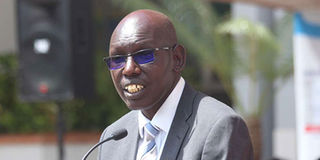New proposal seeks to cut back years in secondary school education

Education Principal Secretary Belio Kipsang. He said the government has allocated money to facilitate improvement of infrastructure in schools. PHOTO | FILE | NATION MEDIA GROUP
What you need to know:
- The government is also hoping to reduce congestion in schools, which has been caused by the 100 per cent transition to secondary school.
- The proposed new system places emphasis on Continuous Assessment Tests (CATs) over one-off examinations.
The government plans to increase the number of years one spends in primary school to nine and reduce secondary schooleducation duration to three years.
The government wants to implement the proposal by classifying the junior secondary section comprising grades seven, eight and nine under the primary section in the new competency-based curriculum.
This will leave the secondary section with only grades 10, 11 and 12. Under the arrangement, learners in grades 7, 8 and 9 (the current form one) will be taught by primary schoolteachers.
This way, the government expects to reduce the cost of putting up new classrooms for learners in the junior secondary section as it will only be required to put up classrooms for grade 9 pupils only.
Learners in grade seven and eight will make do with the current classrooms used by standard seven and eight pupils.
INFRASTRUCTURE
In the other arrangement, the government was required to put up three extra classrooms for each grade in junior secondary schools.
Schools across the country have been facing a crisis in getting adequate and quality infrastructure.
The Budget estimates presented in Parliament by Treasury Cabinet Secretary Henry Rotich last week indicate that starting July, schools will get Sh1.5 billion for infrastructure development.
However, principals of secondary schools have indicated that they need at least Sh9 billion for infrastructure. Education Principal Secretary Belio Kipsang also feels that the current funding is not enough.
The move is also aimed at addressing the problem of teacher shortage, as the available teachers in primary schools will teach students in grades seven, eight and nine.
CONGESTION
The government is also hoping to reduce congestion in schools, which has been caused by the 100 per cent transition to secondary school, as most of the students will be day scholars.
“Primary schools will only be required to have one extra class, therefore making the cost of education cheaper,” reads a report by the Ministry of Education.
The ministry has heeded the advice of external evaluators who indicated that the review process would cost Sh365 billion for the first four years, a figure the government says it has not budgeted for.
The Prof Laban Ayiro report had proposed a new structure of 2-9-3-3, comprising two years in pre-primary, nine years in primary, three years in secondary and three years in tertiary institutions or university.
TRAINING
The Sessional Paper dubbed “Reforming Education and Training for Sustainable Development”, currently before Parliament, explains that the ministry is doing away with the current 8-4-4 system because it does not prepare learners enough.
“This policy document proposes a Competence-Based Curriculum (CBC) to replace the 8-4-4 system. The 8-4-4- system has been widely criticised for being heavily loaded in terms of content and being too examination oriented, putting undue pressure on learners,” reads the paper.
It further explains that the proposed new system places emphasis on Continuous Assessment Tests (CATs) over one-off examinations.
“Reform of the curriculum will ensure that the skills taught in education institutions match the requirements of the industry and will also emphasise national values, integration of science and innovation and adoption of ICT technologies,” it adds.
The paper says that from the primary school cycle to higher levels, the new structure is intended to offer learners equal opportunities to advance to the highest level of learning, either through academic channels or thorough TVET.





